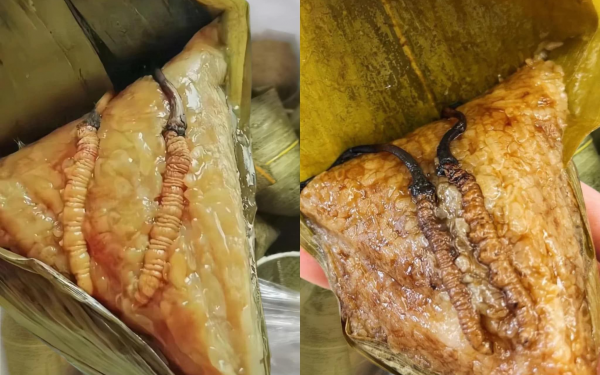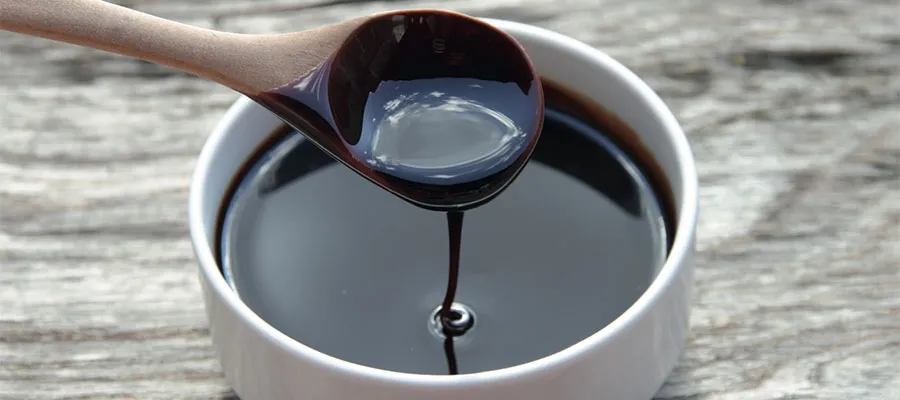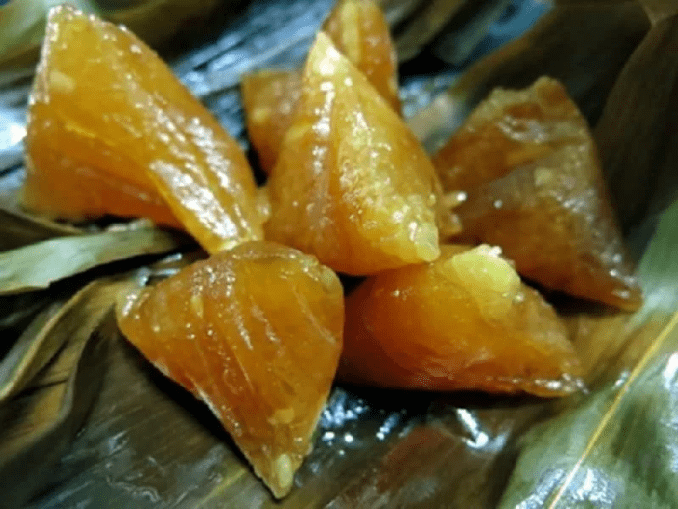Banh tro, also known as ash cake or gio cake, is a Vietnamese delicacy celebrated for its simplicity and distinct taste. Made from sticky rice soaked in ash water, this traditional cake boasts a light, chewy texture and a subtle aroma, beautifully complemented by a dip in sweet molasses. Popular during the Đoan Ngọ Festival, bánh tro is more than just a treat—it’s a symbol of cultural heritage. In this article, we’ll explore the ingredients, preparation, and significance of bánh tro in Vietnamese culture.
The Origins of Banh Tro: A Chinese Influence with a Vietnamese Twist

Banh tro’s origins trace back to Guangdong, China, where similar rice cakes are made with sweet or savory fillings. When the recipe arrived in Vietnam, however, it was adapted to meet local tastes, resulting in a simpler, filling-free version. Traditionally, bánh tro is enjoyed with molasses, which adds a unique layer of sweetness to its mild, slightly bitter flavor. This Vietnamese adaptation exemplifies the country’s knack for blending influences to create unique culinary experiences that honor both tradition and innovation.
Essential Ingredients for Making Banh Tro (Ash Cake)
Creating authentic bánh tro requires only a handful of ingredients, each playing an essential role in achieving its unique taste and texture. Here’s what you’ll need to make approximately 25 pieces:
- 500 grams of yellow sticky rice – Yellow sticky rice provides a beautiful color and the perfect consistency.
- 500 ml of ash water – Traditionally made from plant ashes, such as rice straw or bamboo leaves, dissolved in water.
- Dong leaves (or bamboo/banana leaves) – These leaves wrap the cake, lending aroma and shape.
- Molasses – A sweet, dark syrup for dipping.
- Salt – Enhances the natural flavor of the sticky rice.
- Banh tie string – Thin strings used to tie the cakes securely during boiling.
Step-by-Step Guide to Making Traditional Banh Tro
While bánh tro is simple to make, it does require time and patience, particularly for soaking and boiling. Here’s a guide to creating the perfect bánh tro:
Step 1: Soak the Sticky Rice in Ash Water
Begin by thoroughly rinsing the sticky rice to remove any impurities. Next, soak the rice in a mix of 1 liter of water and 500 ml of ash water for about 22 hours. This extended soak time softens the rice, allowing it to absorb the ash water’s distinct flavor. Stir the rice gently a few times during the soaking process. Once the rice grains are soft enough to break easily, rinse them several times with clean water, drain, and mix in a pinch of salt.
Step 2: Prepare and Wrap the Cake in Dong Leaves
Prepare the dong leaves by washing and drying them thoroughly. Remove any thick veins that may cause tearing. Spread a thin layer of rice, about two fingers in thickness, on each leaf. Fold the edges to form a square or triangular shape, then secure with a banh tie string to keep the rice in place during boiling.
Step 3: Boil the Banh Tro
Place the wrapped cakes into a large pot, arranging them carefully so they remain secure. Cover the cakes completely with water and place a heavy object on top to keep them submerged. Bring the water to a boil, then reduce to a simmer. Allow the cakes to boil for around 2 to 3 hours, adding boiling water as needed to keep them covered.
Step 4: Prepare the Molasses for Dipping

While the cakes boil, prepare the molasses. If store-bought molasses isn’t available, you can make it by heating sugar in a pan until it transforms into a thick, amber-colored syrup. Once ready, let it cool. This rich molasses adds a sweet contrast to bánh tro’s subtle bitterness, completing the flavor experience.
Enjoying Banh Tro: A Simple Yet Satisfying Treat
After the boiling process, remove the cakes from the pot and let them cool. Once cool, unwrap the dong leaves to reveal the translucent, amber-colored cakes. The ash water’s impact on the rice gives bánh tro its unique appearance and flavor. Dip each piece in molasses before eating—the soft, chewy texture paired with the sweet syrup creates a refreshing, balanced treat, perfect for hot weather.
The Cultural Significance of Banh Tro in Vietnamese Festivals
Banh tro is more than a simple dessert. It holds a significant place in Vietnamese culture, especially during the Đoan Ngọ Festival, celebrated on the fifth day of the fifth lunar month. Known as the “Festival for Killing Insects,” Đoan Ngọ is a time for purification, both physically and spiritually. Bánh tro’s mild, slightly bitter taste is believed to aid digestion, symbolizing the festival’s focus on cleansing and wellness. By enjoying bánh tro during this festival, families connect with their cultural roots and honor beliefs about health and renewal.
Banh Tro’s Versatility and Year-Round Appeal

While bánh tro is traditionally associated with the Đoan Ngọ Festival, it has become a beloved treat that’s enjoyed year-round. Its light, natural ingredients make it a favorite snack or dessert for people of all ages. Banh tro’s simplicity and unique flavor have made it popular not only among locals but also among visitors curious about Vietnamese culture.
In some regions, variations of bánh tro cater to contemporary tastes by adding different flavorings or dipping sauces. However, the classic recipe remains widely beloved, preserving the cake’s historical and cultural significance.
Conclusion: Banh Tro as a Taste of Vietnamese Tradition
Banh tro, or ash cake, embodies the essence of Vietnamese culinary heritage. Its journey from a Chinese-origin delicacy to a distinctly Vietnamese treat reflects the country’s creativity and adaptability. Making bánh tro requires patience, but the result—a chewy, mildly flavored cake with a perfect touch of sweetness from molasses—makes every effort worthwhile. Each bite offers a connection to Vietnamese tradition, celebrating simplicity, cultural pride, and the beauty of time-honored flavors.


